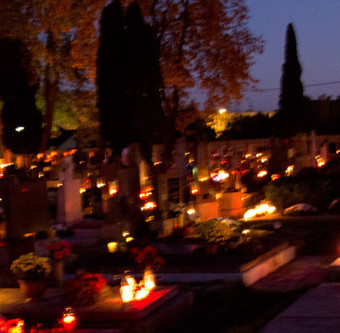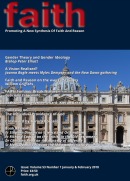
Faith and Reason on the way to St James
The Apostle James the Greater, son of Zebedee, brother of John, deserved the nickname given him by Our Lord. He and John were the Sons of Thunder, Boanerges, (Mk 3:17). They suggested a rather spectacular punishment for an unfriendly Samaritan village (Lk 9:52-56). They (or did they ask mother to do it for them ?) dared to ask Our Lord whether they could sit at his right and left hands when he came into his glory. The response was a sterner question : "Can you drink the cup that I must drink, or be baptised with the baptism with which I must be baptised ?" and an unexpected promise : "The cup that I must drink you shall drink." (Mk 10:35-40) We know (Acts 12:1-2) that that promise was fulfilled, in the beheading of James by King Herod Agrippa in Jerusalem in AD 44. As the old pilgrim song puts it "Primus ex Apostolis, martyr Ierosolimis". The same pilgrim song, and an ancient tradition, tells us that in the intervening 11 years James had preached the Gospel in the land we now call Spain. Unlikely ? Well, what would be the likely response of that Son of Thunder to Our Lord's call (Ac 1:8) to be his witnesses "throughout Judea and Samaria, and indeed to the ends of the earth" ? I can hear him lay claim to one end of the earth, of which they all knew : the promontory in the province of Hispania, which we still call Cape Finisterre.
So the tradition (described in various documents, finally compiled in the Codex Calixtinus ) records James's preaching in Hispania (sometimes with little success, as when, discouraged, he implored help from Our Lady, who appeared to help him enthroned upon a pillar, in the city now called Zaragoza.) Among these early witnesses to the tradition, though far from the earliest, was our own St Aldhelm of Malmesbury (709) and, later, St Bede. The tradition relates that, returning to Jerusalem to face his martyrdom, James was accompanied by Spanish disciples, who took his body back to Hispania, by sea, in a boat guided by angels and made of stone. (Of marble : only the best stone.) Ridiculous ? Well, an engineer once told me that marble would have similar properties to concrete, of which boats are indeed made nowadays.
Landed in a fjord near Cape Finisterre, and overcoming various obstacles put in their way by a wicked (later converted) Queen, the disciples buried James's body in a place near the city of Iria Flavia, and, when their own deaths ensued, were buried there themselves. With time, the location of the tomb was forgotten until in the 9th century a hermit, Pelayo, informed the Bishop of Iria, Theodomir, of the appearance of stars and strange lights and, excavating, they found the tombs of James and his disciples, the place thenceforward being named Santiago de Compostela (of the burial place). (Pelayo ? Theodomir ? Mythical figures, thought many, until in the 1950's Theodomir's tomb was discovered.) Pilgrimage began : first the Christian King from his toehold of Northern territory in Asturias, and, as Spanish Christians slowly reconquered their homeland they invoked Santiago Matamoros, who had appeared to aid them in the battle of Clavijo. In the next Century the Bishop of Le Puy, in France, left traces of his journey. The Codex Calixtinus includes a pilgrims' guide to the four main routes through France, converging on one route across Spain. By the 13th Century, Dante could write, in the Vita Nuova, that "in the general sense, anyone who leaves home is a pilgrim, but, in the particular sense, no-one is a pilgrim except those who travel to the tomb of St James." The scallop shell, abundant in the seas around Santiago, became the emblem of a pilgrim (symbolizing, wrote Pope Calixtus II, the hand, wide open, with which one does good works.)
This apogee of the pilgrimage to Santiago, third in rank after Jerusalem and Rome, yet somehow more quintessentially a pilgrimage, in the footsteps of James, to the ends of the earth, was doomed to decline with the Reformation and the wars that ensued. England played its own part in ending the pilgrimage, through the ravaging of Sir Francis Drake, threatening to sack Santiago. The relics of St James were buried, and (once again) with the passage of time memory of the location faded. Pilgrimage continued in small numbers, and a tradition persisted that the relics were hidden under the high altar, until the Archbishop ordered excavations in 1879. The relics of St James, and his two disciples, were found, studied by the scientific methods of the time, and were authenticated by Pope Leo XIII in his Bull "Deus Omnipotens" of 1884.
"...May pious pilgrimages resume, as our ancestors..." The Pope's words had their effect, slowly. A privilege granted to Santiago by a previous Pope was the celebration of a Jubilee Year whenever St James's Day, 25th July, falls on a Sunday. The first such Holy Year after "Deus Omnipotens" was in 1909, and among the pilgrims was a group from the Archdiocese of Westminster, led by Cardinal Bourne, travelling by sea and train. The resumption of pilgrimage (often on foot) was matched by a revival in the historical and artistic studies relating to the pilgrimage, and the first modern society for this was the Société des Amis de St Jacques and Centre des Études Compostellanes , founded in Paris in 1950. Every country, every region of France and Spain, now has such an Association. Great Britain's own, the Confraternity of St James, (www.csj.org.uk) dates from 1983; Cornwall has the Bredereth Sen Jago. Looking at the figures, showing steadily increasing numbers of pilgrims (with peaks in the Jubilee Years : next one 2021) it seems to me that the turning point in 20th Century numbers was in 1982, the first pilgrimage to Santiago of St John Paul II. The words of his Appeal to Europe are now engraved in the crypt, by the relics of St James : "I, Bishop of Rome and Pastor of the Universal Church, from Santiago, send to you, old Europe, a cry full of love : Come back and find yourself. Be yourself."
Other more practical measures encouraged the revival of the pilgrimage. The parish priest of Cebreiro began painting yellow arrows along the route, and pilgrims now can find these on the Caminos de Santiago from all parts of Spain and all countries of Europe. Some religious houses had an ancient tradition of sheltering pilgrims, and new hostels (albergues or refugios) were founded by pilgrims' Associations, municipalities and families, often relying on donations rather than a fixed tariff. Pilgrims having completed their pilgrimages will often return to welcome other pilgrims in these hostels. The Associations give advice to prospective pilgrims and issue a credencial or pilgrim passport, to be stamped at places along the way. So the pilgrim needs both faith and reason in preparing and making a pilgrimage. Some attention to physical training and consideration of footwear is prudent, but the pilgrim will also find that "less is more" and that setting out is a very small gesture away from the securities of daily life and towards greater reliance on providence. The pilgrim needs faith (and his shell is his reminder of charity) but St James is often considered the Apostle most representative of hope. In Dante's Paradise, Peter questions the poet on faith, but James on hope.
After some suffering and much joy, in the company of those sent to be with him in the pilgrimage, the pilgrim arrives at Santiago Cathedral, prays at the tomb under the high altar, and performs certain other traditional rituals. The Cathedral awards a compostela, a beautiful certificate, in Latin, attesting that one has accomplished the pilgrimage. For this, one needs to have done the pilgrimage by one's own efforts (foot, horse, donkey and bicycle are all acceptable), for a minimum distance (witnessed by the credencial) of 100Km (200Km for cyclists) and performed "pietatis causa", for reasons which the Cathedral translates as "religious" or "spiritual". If any of these do not apply, another certificate is offered (in Spanish). Do only Catholics make the pilgrimage ? Indeed, not. There is a mediaeval poem in praise of the monastery of Roncesvalles, which shelters pilgrims after their crossing of the Pyrenees :
"Porta patet omnibus, infirmis et sanis,
Non solis catholicis verum et paganis."
("The door lies open to all, both the sick and the healthy, not only to Catholics but also to pagans.)
Those without a formal religious affiliation might make the pilgrimage because the pilgrimage as symbolic of human life is an image that they recognize. Even those who are committed to the Church may tend to hide their piety inside several insulating layers, disguised as interest in history, architecture and nature, and a tendency to make jokes about blisters. But we all have had the experience of "miracles of St James", of happy coincidences, and of encounters along the Way which are transforming, like the encounter that James and John experienced by the Sea of Galilee.
Notes:
The Confraternity of St James (www.csj.org.uk) has its Offices and Library at the Anglican church of Christ Church, 27 Blackfriars Road, London SE1 8NY. Tel. 020-7928 9988. Thursdays are open days.





